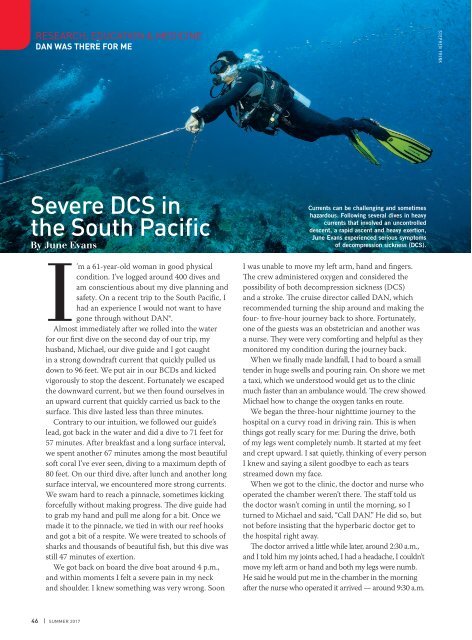AD 2017 Q3
Alert Diver is the dive industry’s leading publication. Featuring DAN’s core content of dive safety, research, education and medical information, each issue is a must-read reference, archived and shared by passionate scuba enthusiasts. In addition, Alert Diver showcases fascinating dive destinations and marine environmental topics through images from the world’s greatest underwater photographers and stories from the most experienced and eloquent dive journalists in the business.
Alert Diver is the dive industry’s leading publication. Featuring DAN’s core content of dive safety, research, education and medical information, each issue is a must-read reference, archived and shared by passionate scuba enthusiasts. In addition, Alert Diver showcases fascinating dive destinations and marine environmental topics through images from the world’s greatest underwater photographers and stories from the most experienced and eloquent dive journalists in the business.
Create successful ePaper yourself
Turn your PDF publications into a flip-book with our unique Google optimized e-Paper software.
RESEARCH, EDUCATION & MEDICINE<br />
DAN WAS THERE FOR ME<br />
STEPHEN FRINK<br />
Severe DCS in<br />
the South Pacific<br />
By June Evans<br />
I’m a 61-year-old woman in good physical<br />
condition. I’ve logged around 400 dives and<br />
am conscientious about my dive planning and<br />
safety. On a recent trip to the South Pacific, I<br />
had an experience I would not want to have<br />
gone through without DAN®.<br />
Almost immediately after we rolled into the water<br />
for our first dive on the second day of our trip, my<br />
husband, Michael, our dive guide and I got caught<br />
in a strong downdraft current that quickly pulled us<br />
down to 96 feet. We put air in our BCDs and kicked<br />
vigorously to stop the descent. Fortunately we escaped<br />
the downward current, but we then found ourselves in<br />
an upward current that quickly carried us back to the<br />
surface. This dive lasted less than three minutes.<br />
Contrary to our intuition, we followed our guide’s<br />
lead, got back in the water and did a dive to 71 feet for<br />
57 minutes. After breakfast and a long surface interval,<br />
we spent another 67 minutes among the most beautiful<br />
soft coral I’ve ever seen, diving to a maximum depth of<br />
80 feet. On our third dive, after lunch and another long<br />
surface interval, we encountered more strong currents.<br />
We swam hard to reach a pinnacle, sometimes kicking<br />
forcefully without making progress. The dive guide had<br />
to grab my hand and pull me along for a bit. Once we<br />
made it to the pinnacle, we tied in with our reef hooks<br />
and got a bit of a respite. We were treated to schools of<br />
sharks and thousands of beautiful fish, but this dive was<br />
still 47 minutes of exertion.<br />
We got back on board the dive boat around 4 p.m.,<br />
and within moments I felt a severe pain in my neck<br />
and shoulder. I knew something was very wrong. Soon<br />
Currents can be challenging and sometimes<br />
hazardous. Following several dives in heavy<br />
currents that involved an uncontrolled<br />
descent, a rapid ascent and heavy exertion,<br />
June Evans experienced serious symptoms<br />
of decompression sickness (DCS).<br />
I was unable to move my left arm, hand and fingers.<br />
The crew administered oxygen and considered the<br />
possibility of both decompression sickness (DCS)<br />
and a stroke. The cruise director called DAN, which<br />
recommended turning the ship around and making the<br />
four- to five-hour journey back to shore. Fortunately,<br />
one of the guests was an obstetrician and another was<br />
a nurse. They were very comforting and helpful as they<br />
monitored my condition during the journey back.<br />
When we finally made landfall, I had to board a small<br />
tender in huge swells and pouring rain. On shore we met<br />
a taxi, which we understood would get us to the clinic<br />
much faster than an ambulance would. The crew showed<br />
Michael how to change the oxygen tanks en route.<br />
We began the three-hour nighttime journey to the<br />
hospital on a curvy road in driving rain. This is when<br />
things got really scary for me: During the drive, both<br />
of my legs went completely numb. It started at my feet<br />
and crept upward. I sat quietly, thinking of every person<br />
I knew and saying a silent goodbye to each as tears<br />
streamed down my face.<br />
When we got to the clinic, the doctor and nurse who<br />
operated the chamber weren’t there. The staff told us<br />
the doctor wasn’t coming in until the morning, so I<br />
turned to Michael and said, “Call DAN.” He did so, but<br />
not before insisting that the hyperbaric doctor get to<br />
the hospital right away.<br />
The doctor arrived a little while later, around 2:30 a.m.,<br />
and I told him my joints ached, I had a headache, I couldn’t<br />
move my left arm or hand and both my legs were numb.<br />
He said he would put me in the chamber in the morning<br />
after the nurse who operated it arrived — around 9:30 a.m.<br />
46 | SUMMER <strong>2017</strong>









